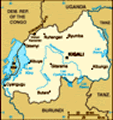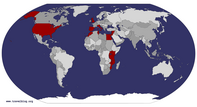Advertisement
Published: April 29th 2008
If you’ve come to Rwanda for anything other than gorillas, your first days are bewildering, full of contradiction. Western knowledge about this country begins and ends with the genocide, yet it’s been almost fourteen years since that terrible chapter in Rwanda’s past was written. President Kagame - despite certain authoritarian tendencies, or perhaps because of them - has helped this country rebuild in ways that most people would’ve considered unimaginable just five years ago. In the past decade, Rwanda’s boasted one of Africa’s fastest-growing economies. Kigali is on a short list of the continent’s cleanest and safest capitals; on its leafy streets, where freshly planted trees litter the sidewalks with their blossoms, you can’t easily imagine the checkpoints, the mass graves, the dogs feasting on the bodies of the dead - scenes played out in endless repetition if you’d walked down these same streets fourteen years ago.
Somehow a country learns to grieve and cope and rebuild; but a country can’t possibly forget - not when the atrocities reach the apocalyptic scale of 1994. Not only in the eyes of the West, but in the eyes of Rwandans themselves, history has been defined by the genocide. It created a world
of “before” and “after,” a world where a boy I meet in the Place de l’Unité National can tell me about the family murdered by Hutu militias, and then ask in the same matter-of-fact voice if I have any brothers back home. In this world grief and remembrance are part of the daily routine; each day the
New Times announces another genocide suspect arrested in France, alongside the latest sports scores or business reports of another solid quarter.
And there are other, more troubling, stories: a school closed in Rusizi district because its teachers were preaching genocide ideology; a body found near Gikongoro in the south - a survivor who testified in a
gacaca court and was the victim of reprisals. Despite its spectacular growth and recovery, Rwanda remains in a low-level conflict with itself. Tension runs high in much of the country; for many, whatever lessons were taught by the genocide have already been forgotten. Eruptions of violence in post-colonial Rwanda have been episodic, generational: ’59, ’73, ’94. Is it just a matter of time, then, before Rwandans start killing again? Or with enough stability and prosperity, enough faith in their common future, can Rwandans build the country
they’ve never truly had?
Against this backdrop I visit the Gisozi Genocide Memorial, a dim, sober tribute to the victims and survivors of ’94. It’s modest in scale, considering the enormity of the crimes behind it. Designed by a local architect - and conceived by a former mayor of Kigali - it has an air of being built as much for the Western world as for the people whose lives and deaths it commemorates. The first section is long on Rwandan history - the bitter years of colonial rule, the first stirrings of ethnic hatred. It’s a frank rebuke to the more popular story in the West, where the easier narrative to swallow was one of “ancestral hatred” - a story line that had less to do with political calculation and economic grievance than some sort of primal bloodlust. It was a theory that fit neatly into the usual Western narrative, where violence is scripted into the African’s DNA, and where blacks killing blacks is how it’s always been.
But it was a narrative that unfortunately ignored historical truths. It was colonial Belgium, after all, that first hardened fluid ethnic identities into dogma, and it was a bitter
and repressive policy by the colonial government that created and fed the violence between Hutus and Tutsis. The history of “ancestral hatred” can only, in fact, be traced back to the first reported ethnic killing in1959 - making it about as ancestral as Little Caesars pan pizzas or
I Love Lucy. By couching the genocide in such bogus historical terms, we were able to wash our own hands of culpability in the massacre: whether or not the West intervened, Rwandans would go on killing each other as they had before.
As more and more evidence of the killings reached Western diplomats, strongly worded warnings and resolutions poured from the UN. But who would sacrifice their own sons and daughters to stop the violence? The slaughter of eighteen soldiers in Mogadishu was still fresh in American minds. There was no political will to involve ourselves in another African mess; there were even misleading reports that the killings were just an extension of the country’s civil war of the early-‘90s. That this didn’t exactly square with the systematic, targeted killings of a distinct minority didn’t seem to trouble our politicians. When Africans start slaughtering each other by the hundreds of thousands,
it’s best not to poke around for details.
The sense of indignation at being abandoned by the West - ignored by the UN, brutally betrayed by the French, who conspired in much of the slaughter - burns throughout the memorial. And the unflinching reports of the killings force us to confront our own shame: how we could let ourselves be complicit in such atrocious crimes. Two sisters thrown into a deep cistern and then crushed by rocks; women crucified on trees; a man shot and left to suffer for three days before the killers returned to finish the job. It’s possible to imagine how a man, when threatened with his own life, might reluctantly bring himself to kill. But to do it with such macabre theatrics involves a certain eagerness and an active imagination. Weapons of the genocide are displayed in trophy cases: rusty rifles and spears, clubs and
pangas, an old chair leg studded with nails. While the West was finding creative ways to stay out of Rwanda - as when Secretary of State Madeleine Albright refused to distinguish between “acts of genocide” and genocide itself - Rwandans themselves were showing their own flair for ingenuity.
A
hundred days, after all, is a very long time to kill.
There’s silent footage of the wreckage, the human carnage, found around the country in the genocide’s aftermath: charred bodies heaped in a church, corpses on the side of the road, children showing deep machete cuts on their heads, or wagging the stumps of their butchered hands at the camera. And there are survivors’ stories played on video screens. A man remembers his second son, Jean-Claude, who used to sit in the living room and listen to the news. “It used to make me think he would be a journalist or a politician,” he says. Jean-Claude was killed by the militias, along with his mother and his siblings. Another man - he must be about my age - remembers how anxious families, desperate to buy protection, bribed the Interahamwe with what little food they had left after the genocide began. For three, four days, his mother bought their survival with goat, with potatoes and rice - whatever scraps she found around the house. Before long there were only beans left; the man knew their time was up. Yet somehow his mother fed them vegetables and passion fruits for dinner on her last night - he can’t imagine where, in those killing fields, she had managed to find passion fruits. His voice constricts around the words, and then he can’t go on. It was the last dinner they would have together.
The stories are played on an endless loop, and there’s something sadly fitting, something bitterly poignant, in that repetition. Survivors - most of them alive for reasons they’ll never understand - will have to bear the weight of their trauma for the rest of their lives. It’s a nightmare they’ll be forced to relive, that will wake them on restless nights, that will shatter the calm of a summer afternoon.
A woman, her hair neatly coiffed in stiff waves, shakes her head at a question posed to her off-camera. “Forgiveness is from God,” she says, her eyes burning. “I am only human.”
It’s in the last room I visit, though, that my emotions get the best of me. Here, while more survivors tell their tales of grief and loss, hundreds of snapshots are hung from the walls. Young and old, frozen in time in their wedding dresses and football kits, their suits and blue jeans, looking solemn, startled, restless, happy, full of human emotion. Here stands a young man in a track suit, his knees slightly bent, as if he’s ready to spring into action, there a couple slices their wedding cake, the frosting licking at their knuckles. Here a woman dances in a pretty blue dress, her stout arms wagging in the air, while two women, seated nearby, double over with laughter. Here a man stands grinning and baffled in a blue tuxedo with a bright pink boutonnière, there a couple lies on a picnic blanket on a sunny hillside, their young daughter curled between them. Here a trim man in blue jeans, smiling, sitting outside his house, pours beer into a plastic cup. Here a woman in floral-print pants, squatting, anxious, looks off-camera toward some unseen troubles, there a frowning old matron, arms folded across her bosom, stares forward candidly through her thick-framed glasses. The poet Czeslaw Milosz once wrote that “to exist on the earth is beyond any power to name.” What words do we have, then, to cope with the enormity of our loss?
Outside the workers are trimming and pruning in the garden. It’s a bright day, full of promise. Nearby a sign cautions, “Please, do not step on mass graves.” A reminder, in this wounded country, to be careful how you tread.
Advertisement
Tot: 0.411s; Tpl: 0.011s; cc: 23; qc: 139; dbt: 0.2432s; 1; m:domysql w:travelblog (10.17.0.13); sld: 1;
; mem: 1.5mb











